The NVIDIA GeForce GTX 780 Ti Review
by Ryan Smith on November 7, 2013 9:01 AM ESTCompute
Jumping into compute, we’re entering the one area where GTX 780 Ti’s rule won’t be nearly as absolute. Among NVIDIA cards its single precision performance will be unchallenged, but the artificial double precision performance limitation as compared to the compute-focused GTX Titan means that GTX 780 Ti will still lose to GTX Titan whenever double precision comes into play. Alternatively, GTX 780 Ti still has to deal with the fact that AMD’s cards have shown themselves to be far more competitive in our selection of compute benchmarks.
As always we'll start with our DirectCompute game example, Civilization V, which uses DirectCompute to decompress textures on the fly. Civ V includes a sub-benchmark that exclusively tests the speed of their texture decompression algorithm by repeatedly decompressing the textures required for one of the game’s leader scenes. While DirectCompute is used in many games, this is one of the only games with a benchmark that can isolate the use of DirectCompute and its resulting performance.
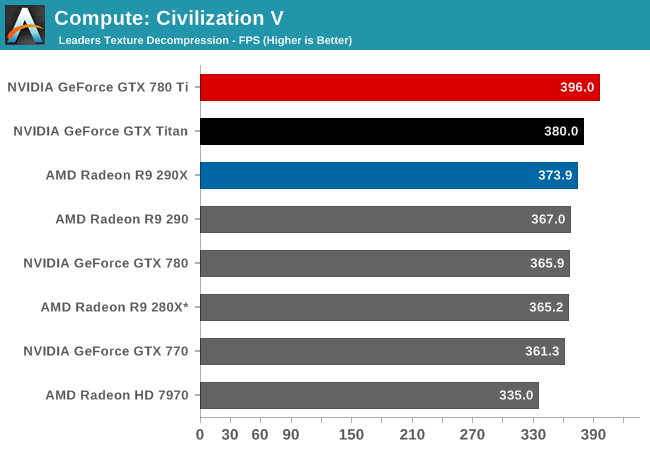
Even though we’re largely CPU bound by this point, GTX 780 Ti manages to get a bit more out of Civilization V’s texture decode routine, pushing it to the top of the charts and ahead of both GTX Titan and 290X.
Our next benchmark is LuxMark2.0, the official benchmark of SmallLuxGPU 2.0. SmallLuxGPU is an OpenCL accelerated ray tracer that is part of the larger LuxRender suite. Ray tracing has become a stronghold for GPUs in recent years as ray tracing maps well to GPU pipelines, allowing artists to render scenes much more quickly than with CPUs alone.
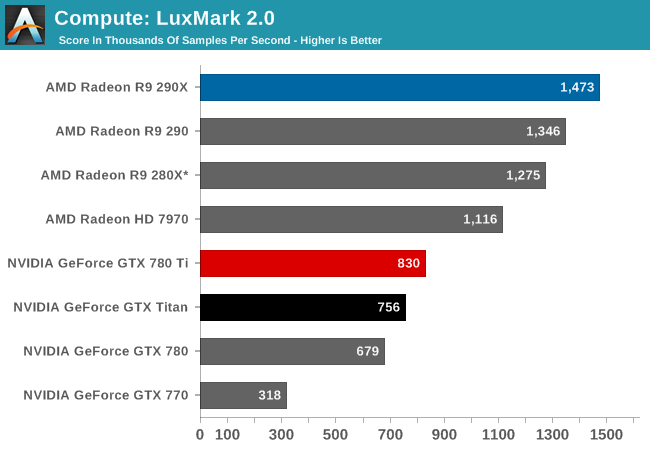
With LuxMark NVIDIA’s ray tracing performance sees further improvements due to the additional compute resources at hand. But NVIDIA still doesn’t fare well here, with the GTX 780 Ti falling behind all of our AMD cards in this test.
Our 3rd compute benchmark is Sony Vegas Pro 12, an OpenGL and OpenCL video editing and authoring package. Vegas can use GPUs in a few different ways, the primary uses being to accelerate the video effects and compositing process itself, and in the video encoding step. With video encoding being increasingly offloaded to dedicated DSPs these days we’re focusing on the editing and compositing process, rendering to a low CPU overhead format (XDCAM EX). This specific test comes from Sony, and measures how long it takes to render a video.

Like LuxMark, GTX 780 Ti once again improves on its predecessors. But it’s not enough to make up for AMD’s innate performance advantage in this benchmark, leading to GTX 780 Ti trailing all of the AMD cards.
Our 4th benchmark set comes from CLBenchmark 1.1. CLBenchmark contains a number of subtests; we’re focusing on the most practical of them, the computer vision test and the fluid simulation test. The former being a useful proxy for computer imaging tasks where systems are required to parse images and identify features (e.g. humans), while fluid simulations are common in professional graphics work and games alike.
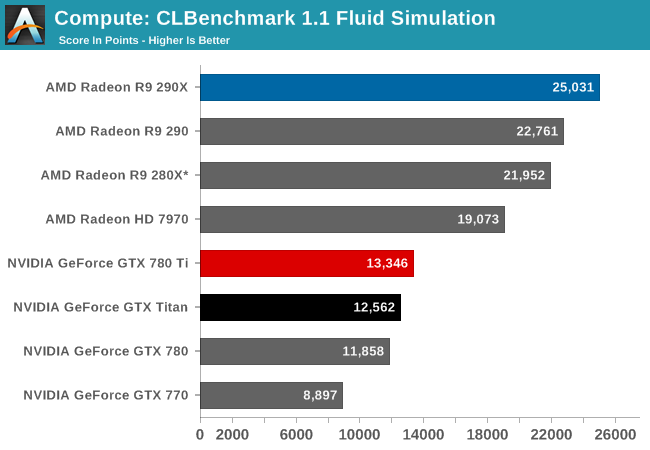
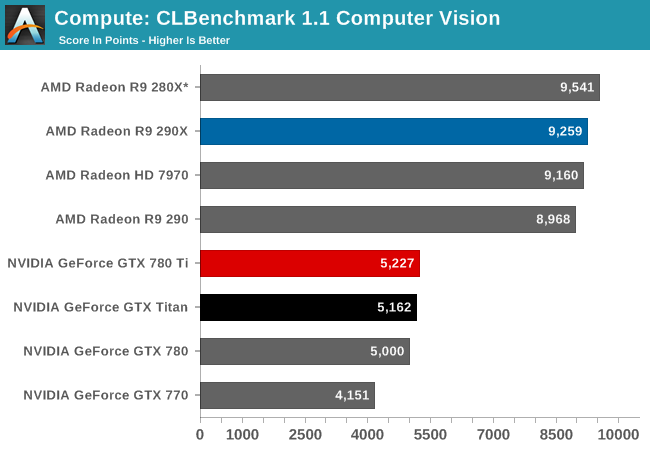
CLBenchmark continues to be the same story. GTX 780 Ti improves on NVIDIA’s performance to become their fastest single precision card, but it still falls short of every AMD card in these tests.
Moving on, our 5th compute benchmark is FAHBench, the official Folding @ Home benchmark. Folding @ Home is the popular Stanford-backed research and distributed computing initiative that has work distributed to millions of volunteer computers over the internet, each of which is responsible for a tiny slice of a protein folding simulation. FAHBench can test both single precision and double precision floating point performance, with single precision being the most useful metric for most consumer cards due to their low double precision performance. Each precision has two modes, explicit and implicit, the difference being whether water atoms are included in the simulation, which adds quite a bit of work and overhead. This is another OpenCL test, as Folding @ Home has moved exclusively to OpenCL this year with FAHCore 17.

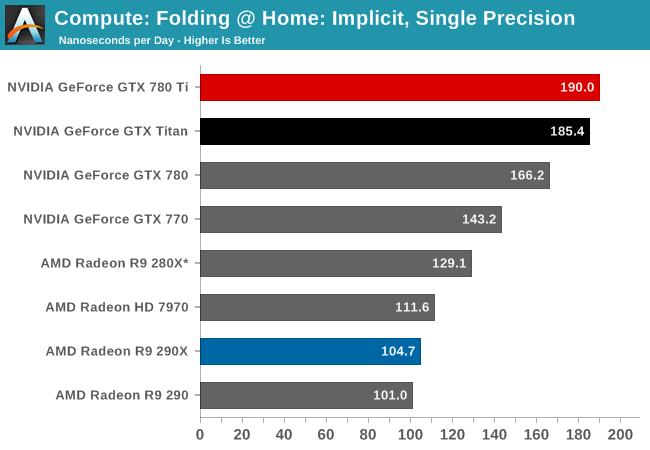
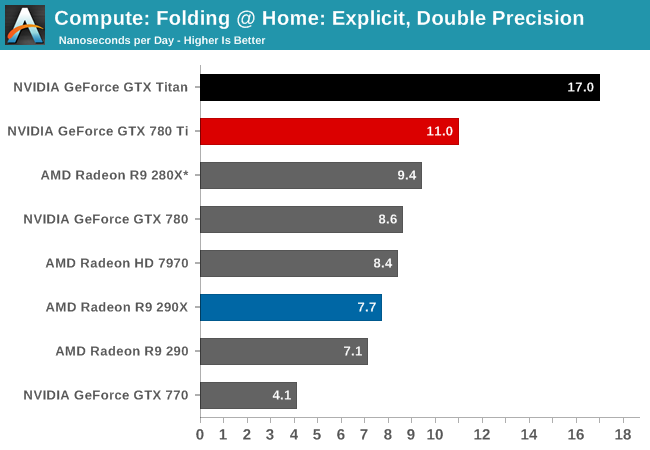
Finally with Folding@Home we see the GTX 780 Ti once again take the top spot. In the single precision tests the GTX 780 further extends NVIDIA’s lead, beating GTX Titan by anywhere between a few percent to over ten percent depending on which specific test we’re looking at. However even with GTX 780 Ti’s general performance increase, in the double precision test it won’t overcome the innate double precision performance deficit it faces versus GTX Titan. When it comes to double precision compute, Titan remains king.
Wrapping things up, our final compute benchmark is an in-house project developed by our very own Dr. Ian Cutress. SystemCompute is our first C++ AMP benchmark, utilizing Microsoft’s simple C++ extensions to allow the easy use of GPU computing in C++ programs. SystemCompute in turn is a collection of benchmarks for several different fundamental compute algorithms, as described in this previous article, with the final score represented in points. DirectCompute is the compute backend for C++ AMP on Windows, so this forms our other DirectCompute test.
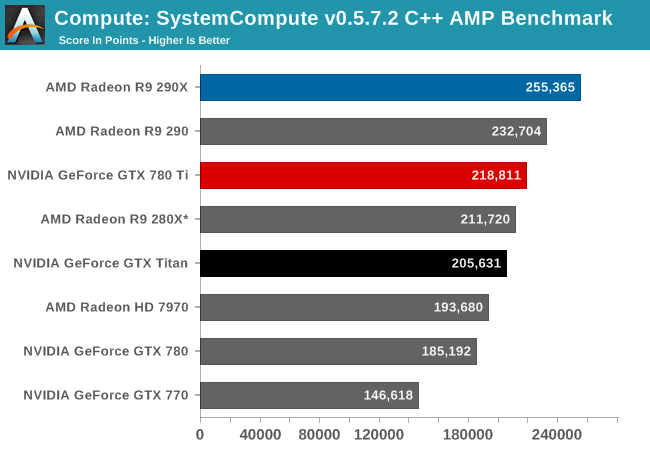
Last, in our C++ AMP benchmark we see the GTX 780 Ti take the top spot for an NVIDIA card, but like so many of our earlier compute tests it will come up short versus AMD’s best cards. This isn’t quite as lopsided as some of our other tests, however GTX 780 Ti is stuck competing with the 280X while the 290 and 290X easily outperform NVIDIA’s new flagship.










302 Comments
View All Comments
1Angelreloaded - Thursday, November 7, 2013 - link
They can't because of antitrust/monopoly laws, the penalties for NVidia would be retarded from the Gov. TBH since ati has been lowballing it lately this has caused NVidia to cap yields for higher prices.Mondozai - Friday, December 13, 2013 - link
EJS the buttboy for Nvidia keeps entertaining us! Dance monkey, dance!Kodongo - Thursday, November 7, 2013 - link
Us? Speak for yourself. If you willingly allowed nVidia to rape your wallet, more fool you. Me, I will go for the best price-performance cards which puts me firmly in the Radeon camp at the moment.1Angelreloaded - Thursday, November 7, 2013 - link
Depends on your perspective, SLI is just better overall, and supported better. I'll gladly pay for a better product versus 1 at mainstream budget with less feature sets.anubis44 - Thursday, November 7, 2013 - link
"SLI is just better overall".Not anymore. HardOCP said: "We've been telling our readers for years that CrossFire just didn't feel as good as SLI while gaming.
Those times have changed, at least on the new Radeon R9 290/X series. The new CrossFire technology has improved upon the CrossFire experience in a vastly positive way. Playing games on the Radeon R9 290X CrossFire configuration was a smooth experience. In fact, it was smoother than SLI in some games. It was also smoother on the 4K display at 3840x2160 gaming, and it was noticeably smoother in Eyefinity at 5760x1200."
Read the whole R9 290X crossfire article here:
http://www.hardocp.com/article/2013/11/01/amd_rade...
Finally, ignore the noise about noise on the reference R9 290(X) cards. The custom cooled versions are coming out by the end of November and they'll be as quiet and cool as the nVidia cards, but faster and cheaper.
TheJian - Thursday, November 7, 2013 - link
You need to read balance sheets: paste from another post I made at tomshardware (pre 780ti)-Simple economics...NV doesn't make as much as they did in 2007. They are not gouging anyone and should be charging more (so should AMD) and neither side should be handing out free games. Do you want them to be able to afford engineers and good drivers or NOT? AMD currently can't afford them due to your price love, so you get crap drivers that still are not fixed. It's sad people don't understand the reason you have crap drivers is they have lost $6Billion in 10yrs! R&D isn't FREE and the king of the hill gets to charge more than the putz. Why do you think their current card is 10db’s higher in noise, 50-70 watts higher and far hotter? NO R&D money.
NV made ~550mil last 12 months (made $850 in 2007). Intel made ~10Billion (made under 7B 2007, so profits WAY UP, NV way down). Also INtel had 54B in assets 2007, now has 84billion! Who's raping you? The Nvidia hate is hilarious. I like good drivers, always improving products, and new perf/features. That means they need to PROFIT or we'll get crappy drivers from NV also.
Microsoft 2007=14B, this year $21B (again UP HUGE!)
Assets 2007=64B, 2013=146Billion HOLY SHITE.
Who's raping you...IT isn't Nvidia...They are not doing nearly as well as 2007. So if they were even raping you then, now they're just asking you to show them your boobs...ROFL. MSFT/Intel on the other hand are asking you to bend over and take it like a man, oh and give me your wallet when I'm done, hey and that car too, heck sign over your house please...
APPLE 2007=~3Bil profits 2013=41Billion (holy 13.5x the raping).
Assets 2007=25B, wait for it...2013=176Billion!
bend over and take it like a man, oh and give me your wallet when I'm done, hey and that car too, heck sign over your house please...Did you mention you're planning on having kids?...Name them Apple and I want them as slaves too...LOL
Are we clear people. NV makes less now than 2007 and hasn't made near that 850mil since. Why? Because market forces are keeping them down which is only hurting them, and their R&D (that force is AMD, who by the way make ZERO). AMD is killing themselves and fools posting crap like this is why (OK, it's managements fault for charging stupidly low prices and giving out free games). You can thank the price of your card for your crappy AMD drivers
Doesn't anyone want AMD to make money? Ask for HIGHER PRICES! Not lower, and quit demonizing NV who doesn't make NEAR what they did in 2007! Intel killed their chipset business and cost them a few hundred million each year. See how that works. If profits for these two companies don't start going up we're all going to get slower product releases (witness what just happened, no new cards for 2yrs if you can't even call AMD's new as it just catches OLD NV cards and runs hot doing it), and we can all expect CRAP DRIVERS with those slower released cards.
mohammadm5 - Monday, November 11, 2013 - link
http://www.aliexpress.com/item/Wholesale-Price-GeF...thats the wholesale price its not nvidia that charges so much is the resellers. the profit nvidia makes per gpu is very low but the reseller make alot of money, also the new amd r9 290 is going for $255 per unit at wholesale price and the r9 280x is going for $160 dollar per unit. you have to also remember thats the distributer price not the manufacturer price,witch should be alot lower. i know the gtx 780 at manufacturer price sells from $200 to $280 depending on brand.
so remember this is america were they sell you something made in china for 1 dollar for 10 dollars
RussianSensation - Thursday, November 7, 2013 - link
Looks overpriced to be honest.I'd rather get MSI Lightning 780 or better yet grab 2 after-market R9 290s once they are out for $100-150 more and likely get 50-60% more performance. High resolution gaming advantage over R9 290X melts away to less than 8%. It looks even worse against $399 R9 290 - only a 15% advantage for a 75% price increase. Terrible value proposition. NV should have priced this guy at $599.
http://tpucdn.com/reviews/NVIDIA/GeForce_GTX_780_T...
A5 - Thursday, November 7, 2013 - link
The article repeatedly points out that is overpriced. Like every other flagship card ever.Anyone looking for price/performance is getting a 280 or 770 (or lower).
Dantte - Thursday, November 7, 2013 - link
Can we remove Battlefield 3 from the benchmarks and add Battlefield 4 please. BF3 is now 2 years old and is no long current with the genre. When's the last time you heard someone say "hey, I wonder how well this card will perform in BF3," I bet not for a while, but I have been hearing that exact statement for BF4 for the last year!